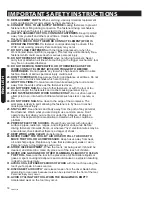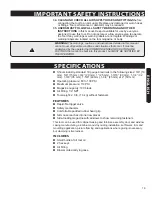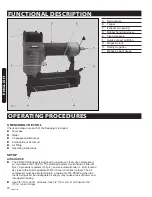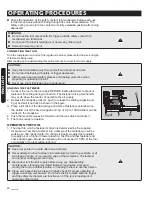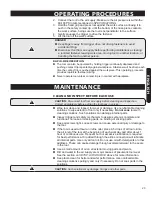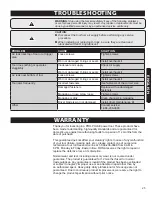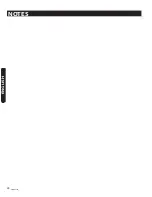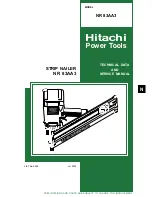
23
E
N
G
L
IS
h
!
!
!
OPERATING PROCEDURES
2. Connect the tool to the air supply. Make sure the air pressure is within the
60-100 PSI limits mentioned in
SPECIFICATIONS
.
3. Hold the hand grip and press tool against the work surface, allowing it to
push in the safety contact tip, until the bottom of the nose piece contacts
the work surface, being sure the tool is perpendicular to the surface.
4. Gently squeeze the trigger to drive the fastener.
5. Lift the tool off the work surface.
DANGER
Keep fingers away from trigger when not driving fasteners to avoid
accidental firing.
Disconnect tool from air supply before performing maintenance, clearing
a jammed fastener, leaving work area, moving tool to another location, or
handling the tool to another person.
RAPID-FIRE OPERATION
The tool can also be operated by holding trigger continually depressed and
pushing contact trip repeatedly against workpiece. A fastener will be driven each
time the contact trip is pushed against the workpiece. This operating procedure
provides rapid-fire fastener driving.
Never operate tool unless contact trip is in contact with workpiece.
MAINTENANCE
CLEAN AND INSPECT BEFORE EACh USE
CAUTION: Disconnect tool from air supply before cleaning and inspection.
Correct all problems before putting the tool back in service.
Wipe tool clean and inspect for wear or damage. Use non-flamable cleaning
solutions to wipe exterior of tool only if necessary.
Do not soak
tool with
cleaning solutions. Such solutions can damage internal parts.
Inspect trigger and safety mechanism to assure system is complete and
functional: no loose or missing parts, no binding or sticking parts.
Keep all screws tight. Loose screws can cause personal injury or damage to
the tool.
If the tool is used without an in-line oiler, place 4-5 drops of air tool oil into
the air inlet of the tool at the beginning of each workday and after about 1
hour of continuous use. Frequent but not excessive lubrication is required
for best performance. Oil added through the airline connection will lubricate
all internal parts. Use only air tool oil. Do not use oil with detergents or other
additives. These can cause damage through accelerated wear to the seals
in the tool.
Use a small amount of oil on all exterior moving parts and pivots.
Dirt and water in the air supply are major causes of pneumatic tool wear.
See the section on
SETUP: AIR SOURCE
above for more information.
Keep tools clean for better and safer performance. Use non-flammable
cleaning solutions sparingly and only if necessary. Do not soak parts in the
solutions.
CAUTION: Such solutions may damage O-rings and other parts.
Summary of Contents for PBN5018
Page 12: ...12 PBN5018b FRAN AIS Notes...
Page 14: ...14 PBN5018b FRAN AIS ENGLISH SCH MA SCHEMATIC DRAWING...
Page 15: ...15 FRAN AIS ENGLISH SCHEMATIC DRAWING SCH MA...
Page 26: ...26 PBN5018b ENGLISH Notes...
Page 27: ...27 ENGLISH Notes...










